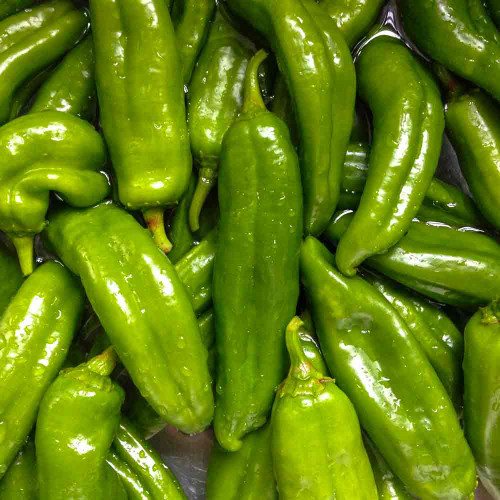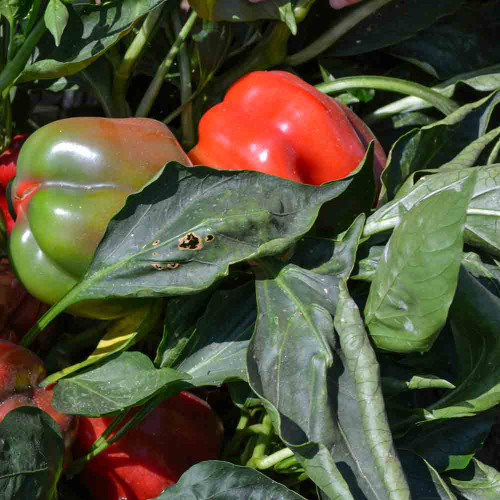Description
Melrose Sweet Pepper - Legendary Sweet Italian Pepper
Looking like their spicier cousins, Melrose peppers are delectable, tender, and sweet, having earned their name from the strongly Italian suburb of Melrose Park just west of Chicago. They’ve become one of the most beloved and eagerly anticipated fruits of the local Italian-American backyard gardens that still grow them. Local markets sell out quickly when word spreads of the arrival of Melrose peppers during the peak season of mid-August.
This treasured sweet Italian frying pepper offers a unique, mild, tender, sweet pepper flavor with an aroma that’s both distinctive and immediately recognized. We often get calls from grandchildren and great-grandchildren of Melrose Park residents, looking for authentic Melrose pepper seeds to grow in their own gardens, so they can share the flavors with their children.
Joseph and Lucia Napolitano brought a handful of their beloved sweet pepper seeds to Melrose Park, IL in 1903 from their little community of Nocera Inferiore, just southeast of Naples, Italy at the foot of Mount Vesuvius, starting an interesting and delicious history in the Chicago area.
Description
Metro Chicago most likely isn’t the first place you think of when sweet peppers are mentioned, but the community of Melrose Park in west-central Chicago has nurtured a sweet Italian frying pepper that has become legendary over the past century.
At first glance, they look very much like a spicy, hot pepper; however, they are nothing but sweet, intense flavor. Sweeter than a bell pepper, they are 4-6” long, thin-skinned, with wrinkled and slightly curved, tapered bodies that ripen from pale green to a deep fire engine red. The flavor deepens and becomes richer and more involved as it ripens, and is used from dark green to red stages. When fully ripe in a deep red hue, these peppers are sweeter than you think, dwarfing anything you’ll get from a bell pepper, making them ideal for pan-frying after stuffing with hot Italian sausage.
Plants are busy with a dense leafy canopy, growing to 3-4’ tall. The plants look like they are decorated with snowdrops when the flower buds first appear because they are so numerous. The fruit starts appearing a couple of weeks later, changing color from light green at 3-4” to a rich deep red at 4-6” long. They ripen in waves, so expect to harvest several times in mid to late August.
History
There are several origin stories about this treasured pepper, as numerous Italian families migrated from the same general area southeast of Naples in the early 1900s and began settling in the Melrose Park area, attracted by well-paying jobs and large tracts of fertile farmland. More than a few brought their favorite pepper seeds along with them.
The history of the Melrose pepper we know today starts with Joseph and Lucia Napolitano arriving at Ellis Island in 1903 from their hometown of Nocera Inferiore, about 12 miles southeast of Naples. In their trunk, they brought the seeds of their favorite fruits and vegetables, including what would come to be known as the Melrose pepper. Once they arrived in suburban Chicago, they began planting the seeds they had harvested from pepper plants that once grew wild in the volcanic earth around their hometown. The Napolitano family began growing peppers alongside other small, family-run farms nicknamed “pepper patches” that sprouted up along North Avenue.
As for the original name of the pepper, Chef Giovanni DeNigris - who comes from Puglia in southern Italy - relates the name of the peppers that most resemble Melrose are known as “friggitelli” and are often sautéed and then stuffed with cheese or meat, usually sausage, or served simply with bread on the side. “Friggitelli” was too hard a word for people to remember, so they began calling them Melrose Peppers.
Tom, the Napolitanos’ eldest son grew up working alongside his parents in the fields. He changed his last name to the easier-to-pronounce Naples and established Tom Naples Homegrown Vegetables and Fruit store, selling the harvests of the family farm from the mid-1920s to its closing in 1985. In the late summer, Melrose peppers sold out almost as fast as they hit the stand. Today, Angelo Caputo’s Fresh Markets still carries the Melrose peppers and still sells out just as quickly.
Tom Naples Jr. remembers working with his grandfather growing those special peppers, “Grandpa Tom would carefully examine the Melrose pepper crop, taking the plants with the biggest and best buds and moving them to a separate row, at the edge of the field. He gifted the peppers harvested from those select, hardy plants, to local ladies, for free; in return, the ladies would string and dry the peppers for use throughout the year in their kitchens, making sure to reserve the seeds for Grandpa Tom, who guaranteed a bushel from the next year’s harvest. We also sold the Melrose pepper plants themselves, first wrapped in newspaper, then in wooden and then plastic flats.”
One of the perennial favorites of the Taste of Melrose Park held every Labor Day weekend is the Stuffed Melrose Pepper: the sleek green or red pepper that tends toward the sweet, making it the perfect pairing with a stuffing of even a hot Italian sausage; the supple skin holds the shape of the pepper and resists splitting.
Uses
Melrose peppers are surprisingly versatile and have inspired many dishes in and around Melrose Park and the greater Chicagoland.
To begin with, they are simply sublime in their simplest form: sauteed in garlic and olive oil and served with a loaf of crusty Italian bread. Freshly picked, the peppers are quite delicate and the skin doesn’t need removing, only lightly fried to bring out their deep delicious flavors.
They are also addictively delectable blended into creamy pasta sauce and served with penne rigate or baked in the Naples family traditional stuffed peppers recipe. Abruzzo’s restaurant in Melrose Park prepares traditional cruschi - fried crispy, potato-chip-like delicacies. They string the peppers and hang them outside to sun dry for 20-25 days in the late summer, then deep-fry them in olive oil. “They have the texture of a chip and taste sweet yet slightly spicy,” says Delia Abruzzo. “Crumble the cruschi over scrambled eggs, serve as a topping for polenta, add to your favorite pasta sauce for an extra kick, or serve as is.”
Their length and leathery skin make them perfect for stuffing. Hot Italian sausage stuffed Melrose peppers are a popular option, and for very good reason, as the mix of sweetness and spice is delicious.
They also work well roasted and dried.
Learn More
- The Story of the Melrose Pepper
- Growing Peppers 101
- Chile and Pepper Growing Tips
- Grow Better Peppers with Shade
- Growing Quality Heirloom Chiles
From the soil to the seed to the food you eat - we'll help you grow your best garden!
1 Review
-
Heavy Production
Good germination, transplanted into the garden first week of May. Very early production of small and attractive red fruit. The production reduced markedly in mid-August, probably due to the hot summer temperatures.













